Diamond reacts with air at temperatures above 650°C. Therefore, the wheels must either be fired at low temperatures, or in an inert, or reducing, atmosphere. Very low temperature bonds, however,
|
FIGURE 6.10 Hot pressed fully densified vitrified diamond bond structure. |
|
FIGURE 6.11 Typical application for a porous vitrified fine grain diamond structure wheel-grinding of polycrystalling diamond inserts. |
were traditionally very prone to dissolution in water. That limited shelf life made air firing unattractive. A simple method was, therefore, developed to manufacture wheels at higher temperatures by hot pressing using graphite molds. The graphite generated a reducing carbon-rich atmosphere locally. Since the mold strength was low, the bond had to be heated above regular sintering temperatures to limit pressing pressures. Consequently, the bonds fully densified with <2% open porosity. Pockets could be generated in the wheel by adding soft lubricant materials such as graphite or hexagonal boron nitride that wears rapidly on exposure at the grinding surface; fugitive fillers were also added to burn out during firing. Nevertheless, the wheels had a major limitation: their bond content was so high they could not be automatically dressed using diamond tools. As such, they fell into the same category as metal and resin bonds (see later) that had to be trued and then subsequently conditioned. This structure has been standard for many years and used extensively in applications such as double disc and Poly Crystalline Diamond (PCD) grinding, although recently it is being superseded by newer technologies.
6.6.6 Porous Vitrified Diamond Bonds
In the last 10 years there has been a revolution in the development of porous cold-pressed vitrified diamond bonds driven by the increased use of PCD and carbide for cutting tools and the growth of engineering ceramics. Vitrified diamond bonds, much used in conjunction with micron sizes of diamond grit, are employed for edge grinding of PCD and polycrystalline boron nitride (PCBN) cutting tools, thread grinding of carbide taps and drills, and fine grinding and centerless grinding of ceramics, for example, seals and some diesel engine applications. A number of these bonds are just starting to be dressed automatically with rotary diamond dressers on the grinder without subsequent conditioning.


